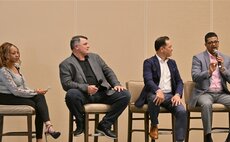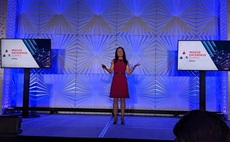
Image created with the assistance of AI
Mike Cisek, VP Analyst at Gartner, delivered a powerful keynote on the current trends and challenges surrounding midmarket IT at Day 2 of the Midsize Enterprise Summit Spring 2024.
Cisek's presentation included findings from two surveys conducted among midmarket IT executives: Gartner's 2024 Generative AI Planning Survey, and MES (Midsize Enterprise Services)' 2024 Spring Midsize Enterprise Summit End User Survey.
The survey results revealed the major trends affecting midmarket IT leaders, and what they say are their top challenges. Cisek also offered advice on the actions IT leaders need to take now to meet these challenges.
Midmarket IT Trends In 2024
One major trend among IT executives, unsurprisingly, is the artificial intelligence push. GenAI is being adopted for specific business uses including sales, supply chain, finance, and customer service. The benefits of AI, respondents said, are automation, cost savings, time efficiency, improved customer service and security, and overall better decision making.
"What are you doing in terms of generative AL?" Cisek asked during his keynote. "In the midmarket in most cases, you are going to be a consumer not a producer of it."

He said it is important to mitigate the risks of GenAI and advised IT leaders to remember the one thing AI doesn't do is "contextualize."
Another trend is the push to drive innovation through data, techniques, and tools. Cisek said that midmarket companies are increasingly using data and analytics "to develop new products, processes, methods and markets."
"Applied innovation," he said, "solves business problems by applying innovative techniques and/or tools."
Other innovation trends include business-model innovation, micro innovation (small, quick innovations done primarily by business technologists), AI-driven innovation, and disruptive innovation.
Modernizing approaches to building software and delivering apps is yet another trend, he said. Most IT leaders surveyed said that most of their application development is done internally (41 percent). Twenty-nine percent said development is done externally, 25 percent said their organizations did no app development or customization and rely on third-party apps, and 6 percent said their app development is outsourced.
Survey results also indicated how IT leaders are handling staffing. The majority of IT leaders surveyed said they look to existing staff to fill new roles or needed skill sets. Here are the other results:

The survey also delved into how confident CIOs felt about their organization's IT skills. Most said there were a few gaps to address, but those needs were expected to be met with additional focus and effort.

Staff turnover and retention rates were other trends explored. Most surveyed said that turnover and retention rates have improved slightly, were on par with historical averages or there has been no change in their staffing.

And a final trend: most IT executives said they were running hybrid environments with an almost even split between on-premise and cloud infrastructures.
Midmarket IT Challenges
IT leaders said one of their biggest challenges was mitigating the risk of using GenAI. Some concerns they cited included risk of inaccuracies/hallucinations; systemic bias; privacy, legal and security issues; implementation costs; issues related to skills and staffing; and ethical reasons.
Other top challenges: dealing with security, risks and compliance; and navigating technology hype.
Fifty-two percent of IT leaders also said that data governance was a concern, and that their organization's data governance strategy was "immature and being developed." Eighteen percent said they were in the process of developing a strategy, while only 16 percent said they had a comprehensive strategy in place. Meanwhile, 14 percent said they had no formal data governance strategy or processes.
And more challenges were cited by IT leaders:
- Controlling cloud costs:

- Dealing with cloud security and integration issues:

"It's really about getting the data and analytics in, you want to funnel that in," Cisek said.
- Tackling multiple security priorities and technologies including NIST /CMMC/CIS compliance, endpoint detection and response, patching, cyber insurance and more:

Overcoming Hurdles
During his presentation, Cisek offered actionable advice for IT leaders to overcome challenges:
- Adopt a holistic approach to digital foundation.
- Align the enterprise around key principles (Cisek suggests using the cocktail napkin cloud strategy as illustrated below):

- Maintain a high degree of cost visibility and discipline. Break out IT spending by asset category and weigh operation costs versus capital IT spending.
- Provide autonomy with operational responsibility. Doing so includes adopting an integration-first approach to exchange, extract and transform data. Using AI/ML, analytics and integrations to enable real-time data-driven decision-making is also key as is investing in low-code, no-code talent.
- Augment skills with managed services in cybersecurity, AI/ML, business intelligence, helpdesk, app development and other skill sets critical to the business.
- Improve the quality of data.
- Use the right formula for AI adoption. According to Ciscek, this includes asking yourself several questions, Cisek said. Among them:
- What are the most valuable use cases for AI?
- Does your team have the skills to implement AI?
- Do you have the data to support use cases?
- Identify and reward top performers on your team.
Cisek also ended his presentation with the advice for IT leaders as they mitigate risks, make plans for GenAI, digital transformation, and navigate staffing and retention issues: they should always adhere to their own standards.
"Look at things that are high-benefit, low-risk," he added.


















